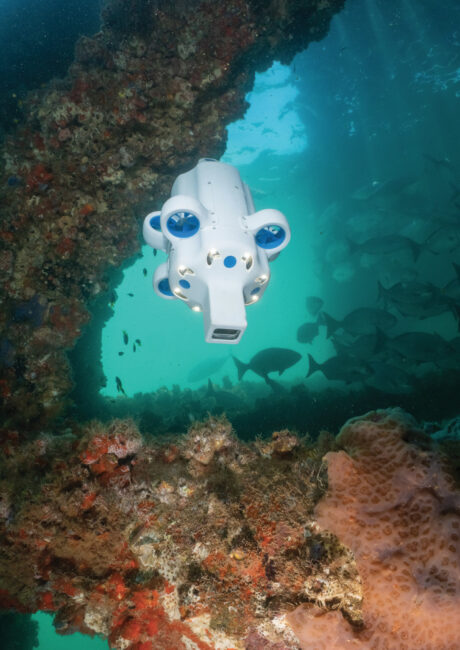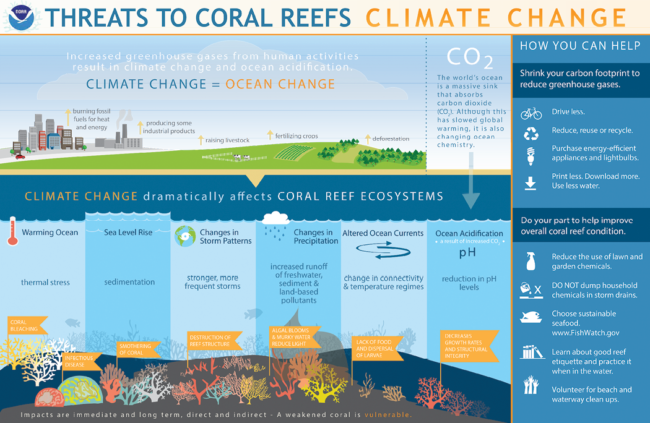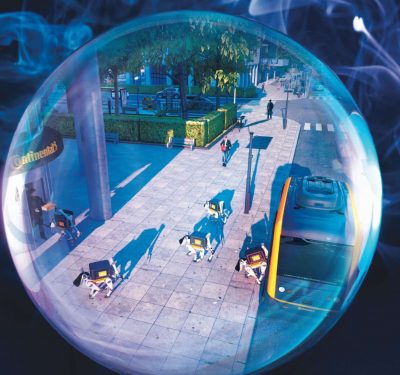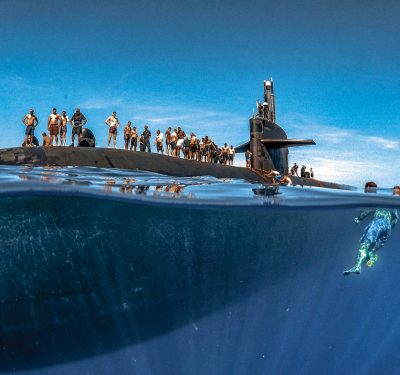Efforts are underway around the world to mitigate the effects of pollution on the marine environment, and to ensure balance is maintained in terms of wildlife and natural resources. Hydrus, by Australia’s Advanced Navigation, is a potent autonomous robot that can help in this and other subsea missions.
Humanity’s relationship with the ocean is profound and enduring. Our ancestors were born there, struggled to survive and crawled onto its shores. They stood up, walked, ran, and ultimately became the planet’s dominant species. Now we are among Earth’s greatest threats, and it falls upon us to better understand and protect its treasures, not least the seas and oceans.

Hydrus is one of the smallest and most affordable autonomous underwater vehicles on the market, while boasting the most advanced navigation and communication systems of any subsea vehicle. Its remarkable performance capabilities make it a powerful instrument for many necessary undersea operations.
Xavier Orr, Advanced Navigation’s CEO, cited some typical applications for the Hydrus system: “Harbor, port and river facilities, and all kinds of underwater infrastructure, such as pipes, cables, bridge footings, moorings, etcetera, all need to be surveyed and inspected. There are also more and more offshore wind turbines. We have vessel hull inspection, and we have aquaculture, where Hydrus is used to monitor offshore fish farms. We have an interesting mine clearing application, using AI to search for underwater mines. Of course, there are a number of other potential applications for users in the security and defense sectors. And we can also just follow divers and film their dives, for a variety of purposes.”
Another key application for Hydrus is marine conservation. The system is currently serving in a number of ongoing projects involving ocean conservation and monitoring. Peter Baker is senior product manager for Advanced Navigation’s Subsea Robotics and Positioning Technology. Speaking at AUVSI Xponential 2022 in Orlando, he said, “Hydrus does have a lot of its own built-in sensors. We’ve got a pressure sensor, conductivity sensor, from that you can determine things like the velocity of sound in water. But there is also provision for third-party sensors, for example, to gather data on ocean changes, sensors for things like pH, acidification, dissolved oxygen levels. We can detect the presence of methane, if you’re concerned about oil and gas operations and you want to know if there are any leaks. So, if you’re an oceanographer looking at an environmental survey, we can tell a lot about the properties of the water.”
FOCUS ON CORAL REEFS
Minderoo Foundation, headquartered in Perth, Australia, manages an impact fund that invests in businesses tackling long-standing social and environmental challenges. The foundation has collaborated with Advanced Navigation on a project to conduct coral surveys on Ningaloo Reef. This UNESCO World Heritage site is Australia’s largest fringing reef and one of the largest coral reefs on Earth. About 1,200 kilometers north of Perth, it is within easy access from the beach and is frequented by whale sharks, humpback whales and manta rays.
Michaela Dommisse is research and infrastructure manager at Flourishing Oceans, responsible for science and development at Minderoo Foundation’s marine research facilities. “We’ve added special samplers to the Hydrus to collect samples for eDNA on Ningaloo Reef,” she said, “and we’ve also explored using it in the deep sea because of its autonomous nature. This is part of a strategic investment in Advanced Navigation targeting the Hydrus as part of its mission to engage the best science and latest technologies in support of ocean and reef conservation.”
Coral reefs are among the most valuable ecosystems on Earth, supporting a greater diversity of species per unit area than any other marine environment, including thousands of species of fish, nearly a thousand species of hard corals and many hundreds of other living organisms, not to mention innumerable species yet to be discovered. Many drugs have been developed or are being developed from species that live in these ecosystems, including possible cures for cancer, viruses, arthritis and bacterial infections. Healthy coral reefs also support commercial and subsistence fisheries, along with jobs and businesses in the tourism and recreation sectors.
“Having a technology like Hydrus is one way of supporting our marine researchers and scientists, including those who are working on our coral reefs,” Dommisse said. “This system provides an automated, unmanned method to collect ocean data such as video imagery. This can replace human divers on SCUBA. As such, much more of the ocean can be surveyed, because the Hydrus is not constrained in space and time like a human. It also means collecting data is a lot safer, because humans aren’t involved.”
Dommisse said while there are many new autonomous units currently being trialed around the world, the Hydrus appealed to Minderoo because of its small size and ease of use from a small boat. “It has very high navigation ability, has a plan to dock and send data from underwater and uses a casing that’s not as affected by pressure and temperature as other systems,” she said.
CROWN OF THORNS
Advanced Navigation has also been helping researchers develop a specialized machine vision application for reef conservation work on the Great Barrier Reef. Hydrus has been used there in efforts to suppress primary outbreaks of the crown of thorns starfish, a venomous, coral-eating predator that occurs naturally on the Great Barrier Reef. It is the world’s second largest starfish, reaching up to 1 meter in diameter and preying on nearly all corals, eating its way through 10 square meters of these organisms in a year.
During an outbreak, when 15 or more starfish are found in a one hectare area, the efficient and meticulous hunters can strip a reef of 90% of its living coral tissue, denuding vast tracts, leaving them barren and incapable of sustaining the multitude of other species that make their living there.
“We have used machine vision with Hydrus in the Great Barrier Reef to identify crown of thorns starfish, and tag or record their locations,” Baker said. “Researchers use the data to track where the starfish are and their numbers. From this, they can take appropriate action to mitigate the adverse effects of the starfish on the reef.” Once the starfish are identified, trained divers can take a variety of actions, one of which involves injecting the voracious creatures with bile salt, a substance made in the liver of oxen, or vinegar, which kills the starfish but doesn’t harm the surrounding ecosystem.
Hydrus’ small size and thruster configuration allow it to move around complex reef structures in ways no other vehicle can. It can also remain in a stable position in one spot, even when the surrounding current is significant. Its unique maneuverability, combined with ultra-high-definition image capture, makes it ideal for AI analysis and photogrammetry. By removing the need for divers and being deployed and recovered by a single person, Hydrus cuts operating costs, allowing monitoring surveys to be performed at higher frequencies, which means greater resolution for complex datasets.
“Video and other data are logged on board the Hydrus, and you retrieve and post-process it after mission completion,” Baker said. During the mission itself, Hydrus software analyzes video footage in real time. At 60 frames per second, the imaging system captures fast movements and is capable of enhanced machine vision, including onboard AI classification and analysis, and can provide real-time decision making and reactivity, enabling immediate action to be taken. Hydrus can also create 3D RGB point clouds by combining imagery with its sonar and navigation data.
“Once these types of projects can be unlocked, we could see a revolution in data collection, like we have seen with drones in the air,” Dommisse said. “The amount of information we could collect on our ocean health will grow exponentially if we had small armies of the Hydrus out collecting in habitats where we can’t easily send humans, such as the deep sea, and over time scales that limit human data collection. Machines never sleep.”
ORIGINS
“Hydrus was born out of working with customers in the ROV [remotely operated vehicle] and AUV [autonomous underwater vehicle] markets,” Advanced Navigation’s Orr said. “We did a lot of integrations in ROVs and AUVs with our INS [inertial navigation system] and sonar technologies, and that gave us the important insights that have led us to where we are today with Hydrus.”
Through its early partnerships, Advanced Navigation was able to understand the challenges facing the kinds of underwater robotic systems they were seeing on the market at that time. “Smaller systems tended to lack sonar, navigation and visual processing power,” Orr said. “But the larger systems that did have these capabilities used many independent modules that made them huge and difficult to deploy.”
Advanced Navigation set out to create an AUV that had all the capabilities of the enormous systems, packed into a small unit that could be deployed by anybody. “We wanted to make the system so simple to use that anybody could operate it without training,” Orr said. “This is what we were seeing in the aerial drone space, and we knew this was the way to open up underwater data to everybody. Most of the jobs we’re talking about are currently done by large ROVs that are very expensive,” Orr said, “and this creates a financial barrier that tends to limit the amount of data that is actually collected.”
Hydrus is wholly developed and manufactured in house by Advanced Navigation, even down to the motors. “We’re using our own Advanced Navigation INS and sonar systems, which we build in Sydney,” Orr said. “The robot itself is put together in Perth, in Western Australia. Apart from that, our biggest suppliers are Sony for the camera system and Xilinx for the FPGA [field programmable gate array]/CPU that powers everything.”
The Hydrus’ sonar and navigation capabilities really set it apart from anything else on the market. These systems allow Hydrus to reliably navigate underwater, avoid obstacles and operate fully autonomously. “Normally, the sonar and navigation capabilities found in Hydrus would only be available in very large ROVs or AUVs,” Orr said. “By integrating them into a much smaller AUV, at a significantly reduced price point, we can offer tetherless AUV operations for any kind of surveying task.”
Hydrus has a very advanced vision system, and it certainly produces stunning imagery, even in challenging, low-light and turbid conditions. With its combination of 4K camera, dynamic lighting and AI image processing, the vehicle delivers high-quality georeferenced footage.
NAVIGATION CHALLENGE

Hydrus’ highly effective navigations system employs ultra-short baseline (USBL) positioning, which determines distances and bearings toward tracking targets “We’re using USBL, which is like underwater GPS,” Baker said. “So instead of using radio waves we’re using sound waves, acoustics. It’s sonar-based positioning. That gives you your absolute coordinate system, latitudes and longitudes.
“Our system goes over the side of the boat, it sends out an acoustic ping, the robot hears it and sends a position back, and the transducer on the side of the boat can then determine the range and the bearing of the object that it’s talking to. It’s called ultra-short baseline because the transceiver baseline is very small, it’s all in one housing. So that will give you the position, and then we use an acoustic modem and we transfer that data down to the robot, using the sound waves, and now the robot has the equivalent of a GPS position.”
For relative position, Hydrus again turns to acoustics. “We have something called a Doppler velocity log [DVL],” Baker said. “So, we’re sending acoustic waves out all around the vehicle, and we’re measuring the Doppler shift on the return echo, and from those different Doppler shifts you can calculate a vector that it’s transiting on. So, it’s not a vision-based system; underwater you’ve got [low] lighting, you’ve got turbidity and a lot of particle matter in the water, and that makes a purely visual system difficult to rely on.”
STRETCHING LIMITS
Orr said Advanced Navigation is continuing its efforts to improve the Hydrus system: “Right now, our robot has a range of 9 kilometers and can operate at up to 3,000 meters depth. There will be larger, longer range Hydrus variants coming out soon. We are working on systems that could range up to 300 kilometers at depths of 6,000 meters.”
Advanced Navigation is putting Hydrus into operation not just in its native Australia but around the world, including within the framework of a number of marine conservation projects off the coast of Florida.
The current market for underwater autonomous systems stands at $1.5 billion, Orr said, while underwater survey is worth $3.1 billion. “These are rapidly growing markets that are pushed forward with revolutionary technology like Hydrus, and we are looking at a growth rate of 23.1% yearly over the next five years. We are incredibly excited to bring the disruptive technology of Hydrus to market. It makes collecting subsea data far more accessible, which in turn can have enormous positive effects in a wide range of different applications.”
Photo courtesy of Advanced Navigation.







